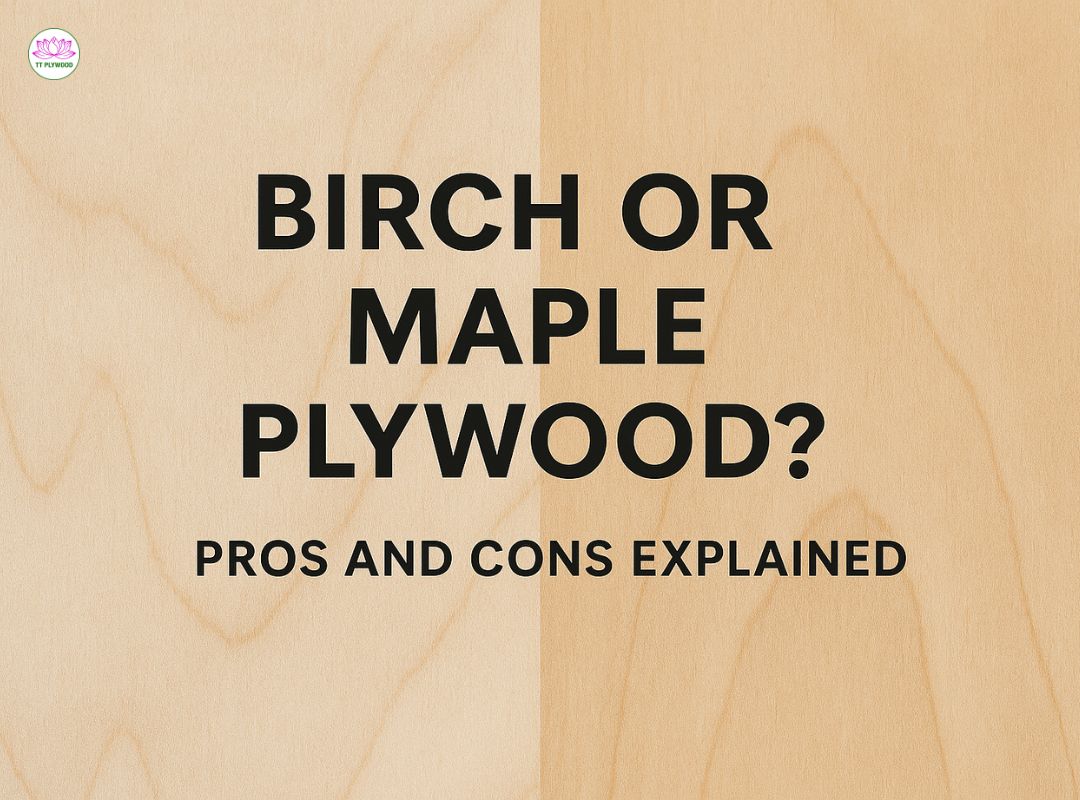-
-
-
Total payment:
-

Birch or Maple Plywood? Pros and Cons Explained
Posted by Thanh Uyên at 22/07/2025
When it comes to premium plywood for cabinetry, furniture, or interior design, two popular choices dominate the market: birch plywood and maple plywood. But which one is right for your next project? This article compares birch and maple plywood in terms of strength, appearance, cost, workability, and more tailored specifically for buyers in the USA, Europe, and UAE. Whether you're a designer in Dubai, a contractor in Berlin, or a cabinetmaker in Texas, this guide will help you make a well-informed decision.

1. Appearance and Grain
Maple plywood typically features a smooth, uniform grain with a creamy white color that suits modern and minimalist aesthetics. It’s often used in high-end interiors where a sleek and polished look is desired. For example, a luxury kitchen in Paris or a contemporary office in Dubai might favor maple for its clean appearance. On the other hand, birch plywood has a slightly more pronounced grain pattern. It presents a pale tone similar to maple but with subtle brown streaks and more visible wood texture, making it ideal for Scandinavian-style interiors or rustic-modern blends. Scandinavian design trends in Europe often favor birch due to its natural warmth and tactile finish.

( Maple Plywood )
2. Strength and Hardness
Both maple and birch are hardwoods, but maple is generally harder and denser. According to the Janka hardness scale:
- Hard maple: ~1450 lbf
- Birch: ~1260 lbf
This makes maple slightly more resistant to dents and wear, making it a better choice for high-traffic cabinetry or flooring. In humid regions like the UAE, both plywood types should be properly sealed, but maple’s density gives it an edge in resisting minor surface damage.
3. Workability and Machining
Birch plywood is known for being easy to cut, screw, and glue. Its slightly softer grain makes it ideal for CNC cutting and beginner-friendly carpentry. For instance, many small workshops in Germany use birch plywood for rapid prototyping and furniture kits. In contrast, maple plywood, due to its density, requires sharper tools and more care during handling. It is prone to burn marks if machined too quickly, making it a bit more challenging for high-volume shops. In the U.S., many cabinet makers prefer birch for its consistency and lower wear on cutting tools, making large production runs more efficient.
4. Finishing and Staining
When it comes to finishing, maple plywood’s tight grain can absorb stain unevenly unless a conditioner is applied first. However, it produces a sleek and premium look when finished correctly, especially with clear coatings. Birch plywood absorbs stains more evenly and provides a warmer tone, making it easier for a variety of stain colors and finishes. For painted applications, both are effective, but birch may offer a more uniform result with less prep work.
5. Cost and Availability

Birch plywood is typically more affordable and easier to find in most markets, particularly across the US and Europe. It is commonly stocked in local hardware stores and mills. Maple plywood, by comparison, is more expensive due to its denser wood and often superior veneer grade. In the UAE, imported maple plywood can be significantly more costly due to logistics and sourcing challenges. To get reliable pricing and export support, buyers can visit TT Plywood’s official website for up-to-date product options and availability.
6. Environmental Considerations
Both maple and birch plywood are considered environmentally responsible choices when sourced from FSC-certified forests. Birch is commonly harvested in Russia, Finland, and Baltic regions, while maple is sourced from North American hardwood forests. TT Plywood proudly offers FSC-certified plywood products that meet international sustainability standards and are available for export across the USA, Europe, and UAE.
7. Best Use Cases
|
Use Case |
Maple Plywood |
Birch Plywood |
|
Kitchen Cabinets |
More durable, polished finish |
Affordable, easy to work with |
|
Custom Furniture |
Luxury-grade look |
Versatile and flexible in design |
|
Painted Surfaces |
Requires prep but high-end result |
Easier to paint and stain |
|
CNC Projects |
Harder on tools |
Excellent for laser/CNC cutting |
|
Budget-Conscious Builds |
More expensive |
Cost-effective & accessible |
Final Verdict: Which Should You Choose?
Maple plywood is an excellent choice when premium durability, elegance, and a refined look are top priorities. It's ideal for upscale furniture, kitchen cabinetry, and flooring in both commercial and residential settings. Birch plywood, on the other hand, offers a more cost-effective solution with excellent versatility and ease of use. It is preferred for general furniture making, DIY projects, and applications where consistent machining is required. Whichever you choose, partnering with a reliable supplier like TT Plywood ensures access to high-grade, sustainably sourced materials tailored for professionals in the US, Europe, and UAE.
Ready to Order?
Visit TT Plywood's product catalog to explore our wide selection of birch and maple plywood available for global shipping. Need a custom quote? Contact our team for export pricing to your region.
Frequently Asked Questions (FAQ)
Q1: Which plywood is better for painting – birch or maple?
Both are suitable, but birch is generally easier to paint due to its more uniform stain and finish absorption.
Q2: Is maple plywood more durable than birch?
Yes, maple is denser and more resistant to dents, making it ideal for high-impact or high-use areas.
Q3: Which is more affordable in Europe and the UAE?
Birch plywood is more budget-friendly and more widely available, especially in European markets. Maple tends to be costlier, particularly when imported.
Q4: Can I use birch or maple plywood outdoors?
Neither is ideal for outdoor use unless properly sealed or treated. Both are best suited for interior applications.
Q5: Does TT Plywood ship internationally?
Yes, TT Plywood offers international shipping and export services to Europe, the US, the UAE, and other global regions.










